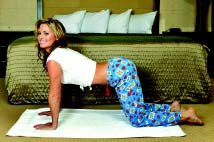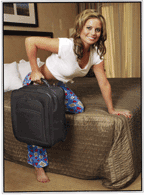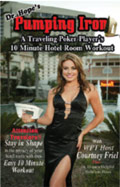|
Starting
Hand Requirements

I’m going to tell you the most important
thing about Hold’em: location, location, location; no wait,
that’s real estate. Ahem, what I meant to say was position,
position, position. Okay, there’s ‘shortstop,’
‘quarterback,’ ‘goalie,’ and… er…
I’m sorry I was reading from the wrong notes. I guess my mind
was elsewhere. What I really mean is your position relative to the
‘Dealer Button’ (that’s the little white disk
with the word ‘Dealer’ on it). Please look at the picture
below.

Sorry, wrong picture this is the
one:

That’s better. Anyway, picture that
you are seated at a poker table and you’re first to act. The
more people there are to act behind you, the more perilous your
position. Reason: you have no information as to the strength of
their hands. With this in mind, you don’t want to enter a
pot in early position with a hand that is vulnerable to a raise.
Because of that I’ve made
this handy-dandy little chart to show you what hands are playable
from what position. Any hand not on this chart is absolutely unplayable,
unless you smell weakness, then they’re all playable. (Remember:
Nothing is absolute in poker, unless of course, you’re talking
about the vodka.)
| Pairs
and Suited Cards |
|
AA |
AK |
KQ |
QJ |
JT |
T9 |
98 |
87 |
76 |
65 |
54 |
43 |
32 |
| KK |
AQ |
KJ |
QT |
J9 |
T8 |
97 |
86 |
75 |
64 |
53 |
42 |
|
| QQ |
AJ |
KT |
Q9 |
|
|
|
|
|
|
|
|
|
| JJ |
AT |
K9 |
|
|
|
|
|
|
|
|
|
|
| TT |
A9 |
K8 |
|
|
|
|
|
|
|
|
|
|
| 99 |
A8 |
K7 |
|
Off |
Suit |
|
|
|
|
|
|
|
| 88 |
A7 |
K6 |
|
AK |
KQ |
QJ |
JT |
T9 |
98 |
87 |
76 |
65 |
| 77 |
A6 |
K5 |
|
AQ |
KJ |
|
|
|
|
|
|
|
| 66 |
A5 |
K4 |
|
AJ |
|
|
|
|
|
|
|
|
| 55 |
A4 |
K3 |
|
AT |
|
|
|
|
|
|
|
|
| 44 |
A3 |
K2 |
|
|
|
|
|
|
|
|
|
|
| 33 |
A2 |
|
|
|
|
|
|
|
|
|
|
|
| 22 |
|
|
|
|
|
|
|
|
|
|
|
|
Blue=6
or more people to act behind you (early position).
Red=5 or less people
to act behind you (middle position).
Green=3 or less people
to act behind you (late position) with at least 2 callers
in front of you in a limit game—no limit you don’t
need any—if you’re first in raise 80% of the time.
Black=on the button
with at least 3 callers in front of you in a limit game—no
limit does not matter—if you’re first in raise
80% of the time.
By counting the people
left to act behind, your opening criteria will automatically
adjust for short-handed play. (This little nifty added benefit
is cool, huh?!) |
Once again, Hold’em
poker is a game of position. (Am I repeating myself?) When
you are in early position with a lot of opponents behind you,
you have very little information. :-(
But when you are
in late position you already know what most of the other players
have done. :-) And you can act
accordingly. Use the chart and it will keep you out of trouble. |
Any hand in Blue, open with
a raise (about 3-4 times the size of the big blind) from any position.
If there are callers (no raisers) in front of you raise about 5-6
times the size of the big blind. If there is a raiser in front of
you, call unless you have one of the top 3 pairs, in which case
re-raise (2-3 times the bet of the raiser).
Any hand in Red or Green or Black,
just call if you meet the position criteria. If it’s been
raised before you, you must fold.
If the pot has been raised and re-raised
before it gets to you call only with the top 3 pairs (AA KK QQ)
re-raise with AA.
How you play from the blinds deserves
some special consideration. Sure, you are last to act, but after
the flop you will be first to act. This is a distinct disadvantage.
As a general rule if the opener
(raiser) is in early position, call only with any hand in Blue and
re-raise with the top three pairs (AA, KK, QQ). If the opener is
in middle position, call with any hand in Blue or Red and consider
a re-raise with any hand in Blue. Definitely re-raise with the top
three pairs. If the opener is in late position, call with any hand
in Blue, Red, or Green and consider a re-raise with any hand in
Blue or Red. Again, re-raise with the top three pairs.
If you are faced with limpers, you
have to determine if these individuals are truly weak. If you think
they are indeed weak, you might try to steal with a raise of a little
more than the total of everyone’s bets. If you’re considering
just calling from the small blind that’s okay too, as long
as you’re getting the right price (pot odds).
I prefer (70% of the time) to raise rather than call for two reasons:
Everyone demonstrated weakness with their limps so there’s
a good chance you’ll win the pot right there. If you get called
and the field is down to one or two players there’s a good
chance the flop will miss them both and if you bet you’ll
win the pot. So you have two chances to bluff at it. Of course,
if you get played with after the flop, you will probably have to
throw your hand away.
This is also how I would play a
premium hand in this spot, so it makes it hard for anyone to figure
out if I have the goods or not. Remember, to a limper a K Q offsuit
doesn’t look so hot facing a raise of 5 or 6 times his bet.
Most good players will lay it down.
If there is a raise and a re-raise
throw away all those suited connecting cards, even A K (especially
if the raises come from tight players). You should only call if
you have one of the top 3 pairs (AA KK QQ) and re-raise only if
you have AA.
Knowledge is power in poker. If
you play the way I tell you to, you will not be playing very many
hands so you will have time to do the most important part of poker:
over tipping the cocktail waitress (just kidding, let’s try
that again.)
Knowledge is power in poker. If you play the way I tell you to,
you will not be playing very many hands so you will have time to
do the most important part of poker:
GATHER
INFORMATION. (How much
was in the pot when he called? What odds was the pot laying him?
Did he fold to a small raise? Did he over tip the cocktail waitress?
Etc.)
But that will be the subject of
my next article, “Gathering Information or How to Over tip
the Cocktail Waitress.”
So what have we learned here?
A. Position is very important.
B. Hand selection relative to position is very important.
C. Dr. Hope likes to over tip the cocktail waitress.
D. Position and hand selection are very important.
Am I repeating myself? Am I repeating
myself? I guess so, but some things in life are worth repeating,
like ‘do you want fries with that? Or I pledge allegiance
to the flag…’ Darn, I guess my mind was elsewhere again,
but I think you know what I mean.
So until next time, remember
the number one thing in poker is to have fun and enjoy it. It’s
not whether you win or lose that counts; it’s whether
I win or lose.
C’ya
Dr. Hope, J.A.P.D
(Just A Pretend Doctor)
To comment on this article click here.
This
article was taken from a book designed to keep poker players in shape
while they are on the road. This easy 10 minute hotel room
workout has helped some world-class poker players stay in shape.
Dr. Hope, for one. Anny Duke told Dr. Hope that Eric
Seidel uses this workout whenever he is on the road. T.J.
Cloutier told Dr. Hope, "There's some good stuff in that book."
The name of the book is:
Pumping Iron: A Traveling Poker Player’s 10 Minute Hotel Room
Workout. Here are some pictures from
it:



Here's
what people are saying about this book:
Absolutely the best book I've ever read in my whole
life! It's hilarious and well written.-- Dr. Hope's mom
If you travel you need this book! You should buy at least one copy
- no wait- at least three copies, of this fantastic innovative
book! --Dr. Hope's publisher

Want
it?
CLICK
HERE Help
support this site by
purchasing
your copy of
Dr.
Hope’s
Pumping
Iron: A Traveling Poker Player’s
10 Minute Hotel Room Workout today!
|